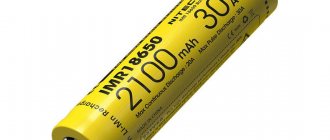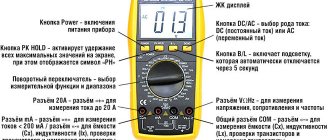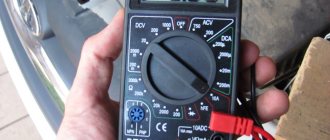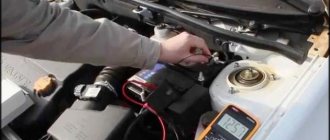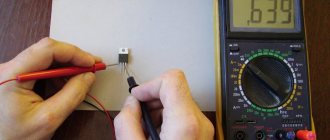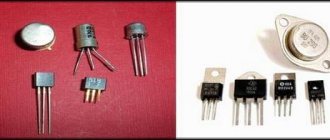Without a working battery, a modern car turns into a pile of iron, even if it is expensive and well packaged. You can check the performance of such an important part using a multimeter. The main thing is to know the features of its use in different situations. To do this, we will tell you how to test the battery with a multimeter.
From this material you will learn how to measure a battery with a multimeter in different ways: how to measure battery voltage with a multimeter, how to measure amperes, etc.
How to check the battery
When learning how to measure battery capacity with a multimeter, you need to consider the procedure for a vehicle battery.
A full check of the autonomous power source will allow you to avoid problems in the vehicle’s electrical network and extend the life of the battery. First, the battery must be disconnected from the machine system. It is allowed to disconnect only the “minus” contact. Next you need to turn on the multimeter. The test mode is set to the range from 0 to 20 V.
The multimeter probes are connected to the battery contacts. A red wire is connected to the positive terminal, and a black wire is connected to the negative terminal. If this procedure is performed correctly, the measurement result will appear on the device screen.
Measurements while the engine is running
Place the car on a level surface, open the hood, put the handbrake on and start it. When the engine is running, the generator and voltage regulator operate, which charge the battery. Therefore, the voltage at the terminals should be within 13.5-14 volts. In some cars, when the battery is discharged and the air temperature is low, the electronics automatically increases the voltage to speed up charging. In this case, it should fall smoothly as it charges. If this does not happen, the electrolysis process is activated in the banks. The electrolyte will begin to boil away rapidly. Overcharging is especially dangerous for modern gel batteries with limited gas emissions.
A voltage of less than 13.4 volts is a sign of undercharging. Operating in such conditions promotes sulfation of the plates and shortens battery life.
When measuring voltage, you need to turn off all powerful consumers: headlights, heater, audio system. Otherwise, the power of the generator when idling will not be enough to maintain the optimal voltage level.
There are several possible reasons for low voltage at the terminals:
- Poor contact.
- Generator failure.
- Voltage regulator malfunction.
You cannot operate a machine whose battery is in undercharge mode. The cause of the failure must be immediately localized and eliminated. If the voltage at the terminals and the output of the generator is very different, you need to clean the contacts on the battery with sandpaper or a file.
After checking without load, you need to turn on the headlights and other powerful energy consumers, add engine speed and repeat the measurements. If at high speeds under load the voltage drops to 13.4 volts or lower, diagnostics of the generator system and control unit is required.
How to test a battery with a multimeter with the engine turned off?
The average indicator, when checking the battery with a multimeter, with the engine not running, should be in the range of 12.5–13 V, with the upper value indicating 100% charge, and the lower value indicating 50%. The numbers are approximate, but the general picture is easy to understand. Also, do not forget that you should take readings immediately before the trip, and not after it, as soon as you have turned off the engine. It is especially good to carry it out when the car has not been used for some time, for example, in the morning after a night in the garage. This shows how well the battery can hold a charge.
Now you understand how to check the charge of a car battery with a multimeter. This device is worth purchasing for every motorist. Some rely on the on-board computer, but it does not provide sufficient accuracy. The built-in voltmeter is connected to the circuit of devices that consume energy, and not directly to the battery, therefore, part of the electricity is consumed “on the road”.
Check internal resistance
To check the battery for serviceability using a multimeter, you need to measure the internal resistance of the battery. You can check the functionality of the power source using a multimeter and a powerful 12 V light bulb. You need to check the battery in the following sequence:
The 12 V lamp is connected to the battery.- After a few seconds of the lamp glowing, the voltage at the battery terminals is measured.
- The lamp turns off and the voltage is measured again.
If the measurement difference does not exceed 0.05 V, then the battery is in good condition.
In the case where the voltage drop is greater, the internal resistance of the power source will be higher, which indirectly will indicate a significant deterioration in the technical condition of the battery.
In this way, it is possible to fairly accurately check the power source for serviceability.
How to Visually Check a Car Battery Case and Cables
Now it's time to check the physical condition of your battery. A damaged battery case can not only prevent the battery from working properly, but can ultimately kill it. To check it, you need to remove it from your car.
Disconnect the cables first, starting with the ground terminal and then the positive terminal. Now unscrew the clamping mechanism to remove the battery from the tray. Make sure the holding mechanism works. If it doesn't exist, install it. This equipment prevents the battery from rebounding and becoming damaged while the vehicle is in motion.
Place it on a work surface or similar surface. Carefully inspect the battery case for possible damage. Check for a bulging side or cover, cracks around the housing, or damaged terminals. If your battery is damaged, replace it. Overcharging and internal short circuit will cause the battery to swell as the acid turns to gas. So if you notice signs of a bulge, check the charging system as well.
Now check the cables. Check the insulation around the cables and the condition of the cable threads for wear, cracks or fraying. Replace them if necessary. Make sure the clamp mechanism on your battery is working.
How is the test carried out depending on the type of battery?
Most batteries used in everyday life are cylindrical in shape. They are called “finger” or “little finger”. All of the above methods are applied to them. The contacts of these elements are located on opposite sides.
There are more powerful power sources - flat batteries of the “Krona” type. The poles of these elements are on one side. Their residual voltage when fully charged is 9 V. Sources with this value below 8.7 V are unsuitable.
Round coin cell batteries have the flat side that is negatively charged and the convex side that is positive. In this case, only current can be measured. For a fully charged battery it should be within 4–6 A.
What parameters can be checked?
Using a multimeter, you can measure voltage with high accuracy. By the magnitude of the electrical voltage, you can determine whether the battery is charged or the element needs to be charged with direct current.
Using a multimeter, you can check the voltage not only of acid batteries, but also of cell phone batteries. To check the mobile phone's battery charge level, the device is switched to the mode for measuring direct current up to 20 V. In this mode, the digital device allows you to measure voltage with an accuracy of hundredths of a volt.
The screwdriver battery can also be easily checked with a multimeter. The rated voltage of the device, in this case, can be found out from the documentation of the power tool, and if the voltage is less than this value, then the battery must be charged.
The battery capacity can also be checked with a multimeter. For this purpose, you can use several methods.
You can check current leakage using a multimeter. If it is necessary to measure this parameter on a car, then in addition to the current leakage on the body, the leakage in the vehicle’s on-board network is also checked.
In this way, you can prevent rapid discharge of the battery and increase its service life.
How to check battery charge with a multimeter?
Determining the condition of a lithium-ion (the most common type of modern battery) battery is quite simple if you follow these instructions:
- Disconnect the energy storage device from the car and wait 5-6 hours.
- The multimeter should operate in the “voltage” mode (voltage test).
- A standard lithium battery produces current in the range of 12.7–13.2 volts. The switch is set to 20 or closest to it. This is how the voltage is measured from this value and below.
- The wires coming from the device are connected to the battery: red to the positive terminal, black to the negative terminal. If the wires are the same color, then you should focus on their markings and connect them to opposite charges, minus to plus and vice versa.
General information
A multimeter allows you to find out the real voltage of the battery, and the readings will be as accurate as possible. In turn, by the voltage you will understand whether the car battery is charged or needs power.
By the way, you can use a multimeter to find out the voltage of phone chargers. Video on how to check 12V with a multimeter using the example of such a power supply:
This meter also allows you to detect current leakage. At the same time, it is important to check for leaks not only on the body, but also in the on-board vehicle network.
In general, checking the battery with a multimeter is possible by:
- capacity;
- resistance;
- current or amperage;
- charge (voltage).
Thanks to this range of measurements, you can minimize the likelihood of rapid battery discharge and increase its service life. And if, for example, you know how to check the starting current of a battery with a multimeter, then you will understand why the engine does not start.
In this useful article we will tell you about the most important things. Let's start with how to measure a battery's charge with a multimeter.
Using a hydrometer to check battery fluid
- Remove the caps from the top of the battery.
- Immerse the tip of the hydrometer into the first cell of the battery and squeeze out the hydrometer bulb.
- Release the bulb so that the electrolyte enters the hydrometer needle.
- Read the specific gravity of the electrolyte as indicated in the instructions on the tool packaging.
- Record your values and perform the same test on the remaining cells.
- Compare your results with the results of the tool manufacturer's instructions.
Basically, if your readings fall between 1.265 and 1.299, your battery is charged. When your readings drop below 1.265, your battery will not be sufficiently charged. In most cases, a slow or fast charge will help restore charge and improve the chemistry in the battery. However, a difference between 25 and 50 points or more (the point is 0.001) between any of your readings indicates that the battery is sulfated and you need to replace it.
Useful tips and general recommendations
Do not check or use leaking batteries. If liquid oozes from them, they can no longer be used anyway.
You cannot store discharged batteries at home, because... they can begin to leak electrolyte and damage nearby things. In addition, their contents are toxic.
Batteries discharge unevenly. If the equipment does not work well, do not throw away all the batteries at once. They need to be checked with a multimeter. Working batteries can be used.
Do not test batteries in a damp room. The surface on which the multimeter is placed must be level and stable.
To extend the service life of elements, follow the rules:
- do not overheat or overcool the batteries;
- use the same power sources in the same device.
The tester will only provide a rough estimate of the condition of the battery. Accurate measurements are made on factory equipment using other methods.
How to check the battery charge using the indicator
Many maintenance-free batteries have charge indicators that allow you to visually determine the condition of the battery. This option first appeared on Japanese products and quickly gained popularity due to its convenience and accessibility.
The hydrometer, as the indicator is called, is a transparent window on the battery cover. The color of the window changes depending on the condition of the battery:
- Green —full charge.
- Gray or white - need to be charged.
For some indicators, the window turns red when capacity is lost.
The principle of operation of the device is based on changes in the density of the electrolyte at different charge levels. It works like this:
A tube with a green float is attached to the window.
- When charging the battery, the density of the electrolyte increases and the float rises, approaching the window.
- If the battery is discharged, the density drops and the ball sinks in the electrolyte. As a result, the indicator window changes color to gray or black.
Some indicator models have a red ball that floats up when the density of the electrolyte decreases. This provides a red indication of the discharge.
When the electrolyte level drops, not the ball, but the electrolyte itself will be visible through the window. To prevent the destruction of the plates, you need to add distilled water to the jars and charge the battery.
The advantage of the indicator is that the device allows you to determine the condition of the battery without the use of special instruments. This is convenient when purchasing a battery or in road conditions when you need to quickly check the condition of the battery. However, indication using a float does not always allow one to draw accurate conclusions about the performance of the battery. Therefore, when in doubt, you should use a multimeter or a load fork. They are also useful when you need to check a battery that is not equipped with an indicator.
Common causes of battery discharge
Batteries are often discharged both due to the fault of the car owner and due to third-party reasons. Of course, the most common reason for a suddenly dead car battery is driver absentmindedness, that is, electrical appliances left on - headlights, lights, radio, etc.
But a much more impressive list is being compiled due to technical problems:
- battery contamination;
- long service life (more than 4 years);
- damaged, outdated vehicle wiring;
- incorrect connection of electrical appliances;
- problems with the generator or its regulator;
- incorrectly selected battery;
- change in electrolyte level and density;
- Frequent trips over short distances at low speeds.
How to Test Battery Terminals Using a Multimeter
Dirty, corroded or loose terminals will lead to starting or no-starting problems and are one of the main reasons people think they have a "dead battery". Sometimes such problems are difficult to detect with a simple visual inspection.
Here you will use a voltmeter (or multimeter set to voltage) to check the battery terminals for voltage drop so you can understand the status of your battery connections.
First turn off the ignition system. Do this by temporarily disconnecting the ignition coil or removing the fuse, or the fuel pump relay (if necessary, find your vehicle's owner's manual or your vehicle's repair manual to locate the coil or fuse). This will prevent your engine from starting.
Use the red positive wire to touch the positive terminal of the battery and hold. Touch the black wire (negative) of your meter to the terminal of the negative wire that goes onto the battery. Have a helper crank the engine. If your meter registers more than 0.5 volts, you will need to clean or check the physical condition of the terminal and terminals.
Now check the other battery terminal. This time, however, use the black probe of your meter to touch the negative terminal of the battery. Now touch the red probe of your meter to the cable terminal connecting to the same battery terminal. Have your helper start the engine and check the voltage reading on your meter. If it exceeds 0.5 volts, you need to check the battery terminal for damage or clean it.
Checking current for leakage
In exactly the same way, you can measure current leakage in a car - with a current clamp or a multimeter. The measurement scheme will be the same as the previous one. Before starting the measurement, you must turn off the engine and disconnect obvious consumers:
- lighting equipment;
- car radio;
- other loads.
If the measured leakage current exceeds a reasonable value (the approximate sum of the remaining loads - car alarms, other car electronics that cannot or are difficult to turn off), you need to look for a problem - short circuit, insulation or contamination overlap, etc. You must understand that if a leak occurs through a contaminated battery case (oil stains, electrolyte, adhering conductive dust), then it will not be detected in this way - the current path will be directed past the circuit being measured. Therefore, at the first suspicion of abnormal consumption, you need to clean the battery case from dirt (for example, wash it with detergents).
Leakage current paths along a contaminated housing.
For more details, read the article: How to find current leakage in a car with a multimeter
How to check the “amperage” of a battery with a multimeter?
To determine the current that your battery produces, you will need to create a circuit with a load. Its role is played by any device or equipment that consumes electricity. To take measurements you will need to take the following steps:
- The device is set to ampere measurement mode, and the switch on it is set to alternating current, which is designated by the English letters AC.
- Disconnect the positive terminal of the battery and replace it with the negative wire of the measuring device.
- To the equipment that acts as a load, connect the negative terminal of the battery and the meter probe with a positive charge.
- Depending on the design, look at the displayed number or count it on the instrument scale.
A serviceable and fully charged battery exhibits readings in the range of 12.6–13 V.
How to measure voltage
If it is necessary to check only the battery voltage, then the multimeter is switched to DC mode. If you need to check a source of electricity whose voltage does not exceed 20 volts, then in this sector the mode switch is set to the 20 V position.
Then the black probe of the multimeter should be connected to the negative terminal, and the red one to the positive terminal of the battery; the device display, at this moment, will show the DC voltage.
Typically, a serviceable and fully charged car battery has a voltage of 12.7 V. If at this voltage the electrolyte density is normal, then the source of electricity can be used for its intended purpose.
The voltage of lithium-ion batteries of cell phones, as well as alkaline or gel batteries, which are used to start the engines of various motorcycles, diesel generators and other devices that require a certain charge of electricity to start operating, is measured in a similar way.
How to test a battery with a load fork?
This is the most accurate method to determine the state of charge and the ability of the battery to operate at full load. It is used by professional auto electricians in service centers.
A load fork is a device that combines a voltmeter and a load resistance. Advanced versions of the device are also equipped with an ammeter, which allows you to estimate the load current. The fork operates in two modes:
- battery voltage measurement;
- imitation of starter operation.
Before starting the test, you should turn on the voltmeter mode on the load plug and connect it to the battery. If the device shows less than 12.7 volts, the battery needs to be charged.
| Voltmeter readings under load | >10.2 V | 9.6 V | 9.0 V | 8.4 V | <7.8 V |
| Charge percentage | 100% | 75% | 50% | 25% | 0% |
First signs of trouble
Before proceeding directly to measurements, it would be useful to evaluate the external signs of a faulty battery and those signals that may indicate impending problems with the battery:
- when you turn the key in the ignition, the starter begins to turn slowly and sluggishly, the engine starts reluctantly and does not always start the first time;
- even if the battery has recently been fully charged, after several engine starts the symptoms described in the previous paragraph appear (the situation is often observed in winter);
- the integrity of the battery case is damaged;
- severe external contamination and oxidation of terminals;
- traces of electrolyte on the surface of the battery.
If any of these signs are present, then it’s time to get serious about checking your car’s battery.
Reinstalling the battery
After cleaning the case, terminals and tray, reinstall the battery.
- Carefully place it on the tray.
- Attach to tray using clamping mechanism.
- Connect the terminals. This time, start with the positive terminal and connect the negative or ground terminal last.
- After connecting the terminals, spread a thin layer of Vaseline around the top of the terminals and terminal posts. This prevents corrosion from accumulating around the terminals.
Measuring battery voltage
Voltage is much easier to measure than current. Because you don't need to bother with the load. We turn on the multimeter in parallel. That is, we simply connect the red probe to the positive input, and the black probe to the negative input. But before that, you need to move the selector to the measurement limit closest to the top. Middle one from above: for a car battery it will be 20 volts, for small batteries - 10, if there is such a limit on the scale. Now you can touch the battery terminals with the probes - black for minus, red for plus.
Quick battery check
In some cases, car owners have absolutely no time to disconnect the battery from the car, as well as “digging” with the lighting and dashboard. Such car owners determine the battery charge level without removing it, right under the hood.
The process looks like this:
- When the car freezes after turning off the engine, the multimeter is connected to the battery according to the scheme: plus to “+”, minus to “minus”, respectively. It is worth considering that the indicators will have minor deviations. 12.7 Volts is a normal indicator.
- Then the car starts. When the motor starts, the voltage will rise to 14.7 Volts.
- It is recommended to check it under load (external lighting, window heating, medium heater mode). In this case, the norm is 14.6 Volts.
Measuring the voltage of a car battery with a multimeter is a feasible task even for a novice car enthusiast. Not everyone can afford an expensive battery equipped with a special indicator.
A practical and universal option is to measure the battery charge with a multimeter. This device, with a talking prefix “MULTI”, allows you to measure not only voltage, but also current. In addition, the multimeter can be useful for other electrical equipment, including phones, laptops, and screwdrivers. Remember that it is better to purchase such a device from trusted manufacturers in specialized stores.
Other ways to check a car with a multimeter
The cause of battery failure, voltage surges or incorrect operation of the dashboard is a malfunction of the sensors. The location of the parts can be found by reading the vehicle's operating instructions.
ABS sensor
In this case, you need to check the resistance and voltage. Start by choosing the appropriate mode. The normal resistance is 1.2-1.8 kOhm. The multimeter is connected to the sensor, and the wires going to the part are moved. If the value on the tester screen increases or decreases, the sensor requires repair. Measuring voltage is more difficult. To do this, you need to spin the car wheel while monitoring the multimeter readings. The normal sensor voltage is 2 V.
Crankshaft sensor
The part is triggered the moment the engine starts. If it malfunctions, the car cannot start. If there are no visual signs of failure, use a multimeter. The device is switched to resistance measurement mode and connected to the sensor. The norm is 550-750 Ohms.
Oxygen sensor
This device detects residual oxygen in exhaust gases. Before checking, the sensor is inspected for damage. If there are no visible signs of malfunction, measure the resistance and voltage. After starting the engine, observe the instrument readings.
At the moment of startup, the number 0.1-0.2 appears on the screen. After the car warms up, the voltage rises to 0.9 V. If the reading differs from normal, the sensor is faulty. A resistance of 10-40 ohms is considered normal.
Knock sensor
The sensor is used to detect the shock wave generated during fuel combustion. The amount of resistance depends on the car model. To measure the voltage, the sensor is dismantled, the positive probe of the multimeter is connected to the signal wire, and the negative probe is connected to ground. The part needs to be hit against a wall or floor. This is the only way the device can record the voltage. The normal value is 30-40 mV.
How to clean a car battery
- Cleaning the battery case
You can use a simple procedure to clean the battery case. To do this, you need to prepare a mixture of 8 ounces of warm water and one tablespoon of baking soda. This neutralizes the acid and helps remove dirt from the battery case and terminals.
Wear safety glasses and rubber gloves and, using a soft brush, apply the solution to the top of the battery and the sides of the case. If your battery uses compartment caps (serviceable batteries), do not allow the mixture to seep under the caps and mix with the electrolyte inside.
Wipe with the solution and a clean rag. Continue applying the cleaning solution until you see no signs of buildup.
- Cleaning the Battery Terminals
As with the battery, remove dirt and corrosion from the terminals using baking soda and a water solution.
To make your task easier, pour the mixture into a Styrofoam or similar disposable cup and submerge the battery terminal in it for a minute or two. Next, use a battery compartment cleaning tool to finish removing corrosion from the terminals. Repeat the procedure until you see that both cables are free of corrosion.
- Cleaning the battery compartment
Check the condition of the battery compartment. Make sure there are no screws, cracks, pieces of dirt or signs of corrosion. If necessary, use the same solution to remove dirt and corrosion from the pan.
General information about the multimeter
This electrical measuring instrument is often called a “tester”. It can be digital or analog.
There are small, portable instruments, and some are larger and are used for continuous measurements.
2 multimeter probes are connected as follows:
- insert a black plug into the socket marked “COM”;
- into the “VΩmA” connector – a red cord.
Purpose
The multimeter measures current, voltage and resistance. Measured parameters and their most common ranges:
- Constant current: 0.2, 20, 200 mA; 10 A.
- Constant voltage: 0.2 mV; 20, 200, 1000 V.
- Variable voltage: 0.2, 750 V.
- Resistance: 0.2 ohm; 2, 20, 200 kOhm; 2 mOhm.
The multimeter measures voltage and current resistance.
The multimeter does not measure alternating current.
Functionality
In everyday life, small portable devices are most often used. Digital instruments are usually called multimeters, and analog instruments are called testers. Portable devices are battery powered. Using this device, you can find a break in the wiring, determine the capacitance of a galvanic cell, find out the load current in the relay, check the electric motor and much more.
The measurement error depends on the capabilities of the device and ranges from 10 to 0.01%:
| Number of digits | Error, % |
| 2,5 | 10 |
| 3,5 | 1 |
| 4,5 | 0,1 |
| 8,5 | 0,01 |
The number of digits is the number of decimal places in the displayed result. The fractional part means that another position will appear if some condition is met. For example, a resolution of 2.5 means that the final value will be displayed on the display with an accuracy of 2 decimal places, and the third will appear if you change to another range.
How to make a device with your own hands
When the necessary equipment is not available, you can make the device yourself by watching the video. It is necessary to take a voltmeter from ready-made instruments, and the remaining parts are constructed from improvised means. Difficulties will arise when calculating and creating internal resistance, which requires current.
A suitable material is nichrome wire, used to create heating coils in electric stoves. Nichrome elements can be replaced with a metal strip from other heating devices.
For a voltage of 12 V, the current indicator should be within 80-120 Amperes, and the resistance should be 0.1-0.15 Ohms. A device for measuring such resistance is difficult to find. For this reason, the length of one element is selected and the current that it passes is measured. After this, several similar parts are combined.
A homemade device is made sequentially:
- Select a nichrome wire or heating strip and measure the current up to 15 A with a multimeter. The element should pass 10-12 A.
- 10 such parts are connected, receiving a load of 100-120 A. The wire must be twisted securely.
- The resulting element is placed in a suitable housing and fixed in it. If the box is small, then the wire is bent several times so that the turns do not touch each other. The parallel connection must be reliable, which is ensured by insulating cylinders that are installed on the bends.
- The ends of the twist are soldered to the output contacts, and from the outside to the connecting wires.
- Connect a voltmeter.
- Clamps are attached to the ends of the connecting cable, which are then connected to the battery.
When the device is ready, you can take measurements at home.
What to check with a multimeter
After getting acquainted with the main parameters of faults, it’s time to find out what is measured in the battery using a multimeter.
Multimeter
The answer is pleasant: almost everything. This includes voltage, capacitance, internal resistance, and leakage current.
That is why the multimeter has such a name - it measures many parameters at once.
Basic Capacity Concepts
Checking the battery capacity is carried out to determine the technical condition of the power source. This indicator indicates how long the battery will be able to power the consumer under certain operating conditions. The measurement is carried out in ampere hours, the capacity can vary over a wide range.
The parameter is taken into account when considering the possibility of connecting several sources of electricity into one battery. Among the features, the following points are noted:
- With a series connection, the capacitance remains constant, only the voltage is added. Due to this, the starting current increases, but the battery life at a constant load remains unchanged.
- Parallel connection allows you to increase the capacity without changing the voltage. Such batteries are created to ensure long-term operation of various consumers.
A combined connection method is also used, which involves the use of several batteries. There are quite a lot of different rules for creating and charging such batteries, for example, all batteries used must be in good technical condition and have the same capacity.
The capacity largely depends on the amount of electrolyte, if we consider the option of lead-acid batteries for cars.
The liquid level is tested using a regular glass rod. Other power supply options can be checked using various measuring instruments.
Applicable verification methods
In addition to the multimeter, other methods for checking a car battery can be used. The following are common:
- The design of older car batteries makes it possible to measure the density of the electrolyte. However, modern versions are characterized by a sealed housing that does not have holes for measurements.
- The load fork has become widespread. It is represented by a handle with two probe terminals that connect to the power source. The device has a scale from which the required information is read.
- A special tester for lead-acid batteries is an electronic device that is capable of providing all important parameters within a few seconds: voltage, capacity, estimated service life.
- Test charge is another method that is used extremely rarely today. Its features include the need to fully charge and connect a certain load. A test like this takes quite a lot of time.
For frequent battery testing, it is recommended to purchase a special tester. Its cost can be several tens of thousands of rubles. It only takes a few seconds to check the status of the power supply when using it.
Battery testing of tools
Some tools, for example, a screwdriver, are powered by a built-in battery. You can check the battery capacity in various ways; testing is recommended periodically. Among the features of checking instruments, the following points should be noted:
- Before measuring capacitance, the current voltage value is determined. The indicator is taken while the battery is charging. Within 30 minutes after connecting the battery, the first readings are taken when using a multimeter. It should be around 13 V.
- The next few measurements are taken after half an hour and two hours. The readings should be 13.5 V and 14 V, with a full charge of about 17 V.
- Voltage readings that are too low indicate that some parts of the battery may have failed. Individual energy sources are connected in series, thereby increasing the voltage value.
- When measuring capacitance, an additional load is required, which is often a 10 V light bulb.
- A light bulb is connected to a fully charged battery using two wires. It begins to burn, after which the time required to completely discharge the energy source is recorded. For a device of Chinese origin, it will take about 2.5 hours.
- If the light bulb disappears quickly, this indicates a small capacity. It can be calculated as follows: 10 W/18 V x 0.5 hours. This formula uses the load indicator, voltage (measured with a multimeter) and the time it took for the battery to lose its charge. In the case under consideration, the indicator is 0.28 amperes per hour, which indicates the need to replace the source of electricity.
If the tool is used frequently, it is recommended to check it periodically. If the container drops significantly, it can only be used for a few minutes. It is almost impossible to restore the battery; you have to replace it.
Factory and homemade battery testers: review of models
Chinese industry has launched a mass production of cheap electronic devices that make it possible to quickly assess the real condition of any galvanic element. It is enough to insert it into a stationary socket and the test result will immediately be displayed on the display.
The cost of such testers does not exceed a few dollars, and delivery is free.
View more details and order tester BT-168D
As an example, I show the BT-168 tester. Its scale is made of colored sectors, indicating the current state of the current source. The position of the arrow indicates the remaining charge:
- green - normal;
- yellow - acceptable;
- red - for scrap.
A similar model of the BT-168D tester works the same way, but shows the voltage value at the terminal terminals of the current source in volts. A reference table for decoding the values is available on the back of the case.
The universal battery tester has similar capabilities.
Its design and appearance can be made in various ways to test all types of existing batteries.
However, the internal structure of all these devices is approximately the same: an electronic board with a chip and configuration elements.
I suggest watching a more detailed overview and capabilities of such devices in the video of the owner of “China Good Bai” using the example of a tester for batteries of C, AA, AAA, D, N, 9V formats.
I understand the desire of some home craftsmen to do everything with their own hands. I am publishing the next section for them.
What is a battery and what electrical characteristics determine its performance?
The popular name battery is assigned to galvanic cells or chemical current sources that generate electricity to power household appliances and electronic gadgets.
They are usually produced in finger form with dimensions AA or AAA or in the form of tablets.
Functionally, they may or may not have the ability to charge after intended use (batteries). In the first case, the inscription “Rechargeable” is placed on their body.
In the instructions for other models they write that they cannot be charged, that is, they work one-time until they are completely worn out. This must be taken into account, because when they are installed in a charger under voltage, they can explode.
There was such a case in my practice when a neighbor on the top floor damaged her landline phone. She had nickel-cadmium batteries in her tube, which became unusable after a few years.
She replaced them with batteries of the same shape, talked, and placed the handset on the base... she had to buy a new device.
Be careful not to repeat such mistakes.
The performance of a battery is determined by the amount of electrical power that it is capable of delivering to a connected consumer. At the same time, a potential difference is formed at its terminals in the open state - a voltage that, when connected to any resistance, produces an electric current of a certain strength.
It cannot flow indefinitely, but acts only for that period of time for which the energy stored in the chemical current source is sufficient. All of these processes are interconnected, summarized by the term “battery or accumulator capacity” and described by mathematical formulas.
For example, a car battery has a capacity of 60 amp-hours.
This means that at a load current of 1 ampere it should work for 60 hours, and at 60 amperes it should last only an hour.
The same requirement applies to batteries, only their power is much less. Their capacity is marked in milliamp-hours.
The main electrical characteristic of a battery is its capacity . It determines the duration of operation of the chemical current source, that is, its resource.
Its value constantly decreases during operation, and the rate of decrease strongly depends on the connected load.
The results of one of the verification tests of four identical batteries at different consumer currents showed the following results.
In life, we constantly encounter this: the larger the connected load, the faster the chemical current source fails. Therefore, for each electrical device, its own galvanic element is selected according to its power.
2 factors that can damage a battery from the factory before use: you need to know them
These include:
- time;
- freezing.
I will dwell on them in more detail, because in some cases you won’t even have to use a multimeter.
Storage time and service life of a chemical power source
My neighbor in the country bought a wireless mouse for his laptop. She successfully worked for him for six months, and then refused. He came to me with a question.
We looked at the batteries, there are two AAA ones. They have completely exhausted their charge: they need to be replaced. The neighbor asked his friend, who was traveling to the city, to bring him similar ones.
The next day he asks me again: the power supply has been replaced, but the mouse does not work. I removed the AAA from the case: they have the year of manufacture 2013 on them, when it is now the height of summer 2022. The expiration date has long expired.
It is indicated on the packaging (usually 3 years), and the date of manufacture is indicated directly on the body of the galvanic cell.
This is explained simply: it is almost impossible to completely eliminate self-discharge currents. They are taken into account by their expiration date.
Why you need to pay attention to storage conditions
Let's say we bought batteries for my neighbor at a kiosk on the street. In our country, the period of negative temperatures lasts for six months, and in more northern regions it lasts even longer.
During frost, the capacity of any chemical current source is subject to greater self-discharge; it loses its service life before the specified time.
Considering these two factors, I generally do not buy batteries at kiosks and always check their release date, which I advise you to do.
Checking the laptop battery capacity
There are ways to find out the capacity of a particular device, using, for example, a special portable tester for computers. However, it is very expensive in cost, about 30,000 rubles, and such devices can be found mainly in service and repair centers.
People well versed in electronics know how to determine the capacity of each of the 18650 lithium-ion batteries that make up the power supply unit of the laptop. They can skillfully disassemble the battery, measure the voltage at the poles using a voltmeter, and check the battery capacity with the popular “people’s charger” Imax B6. However, this technique requires certain skills and abilities, in particular, opening the computer battery pack. Therefore, it is better for beginners to use special programs and applications.
At home, it is usually recommended to check your laptop battery using the AIDA64 application. It needs to be downloaded and installed on your computer. Then fill the battery completely, disconnect the laptop from the network and run the program. In the window that appears, find the “Power supply” option, click on it and view all the main parameters of the current state of the battery: whether it works well or poorly, what its capacity is and the degree of wear.
When using any laptop using a high-capacity 18650 battery, it is important to remember that it must first be charged from the mains and then completely discharged. If the computer is constantly plugged into a power outlet, without discharging the battery, its actual capacity drops, and it can very quickly fail.
